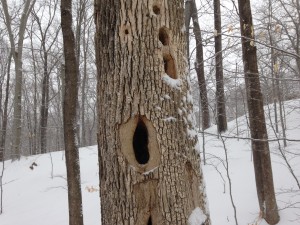Hello fellow readers, Colorful birds against the leafless trees indeed pop. And the healing sounds of nature improve health and well-being, even in the winter.
We celebrated ringing in the New Year with dear friends who are both musical. Jim Ratcliff teaches piano, and Ruth is a voice instructor and, more recently, delved into sound healing. She shared a video of how sounds impact cells, and the animation reminded me of Kaleidoscopes. Remember them as a kid? You looked through a telescope-like thingy and twisted it around to see the geometric shapes.
Sound can improve health and well-being.

Photo by Malcolm Lightbody on Unsplash
Several studies show how sound impacts our cells. The same is true for animals and plants. We’ve spoken about Forest Bathing – about being in the woods, observing the sights, sounds, smells, touch, and tastes surrounding you. Then there are other senses you gain from being in nature, a sense of well-being and belonging.
Given the breakthrough mud season after the deep freeze (“not a good day for dogs,”) we took to a road rather than a walk in the woods on New Year’s Day. Living in farm country, we can enjoy nature easily, but it’s true wherever you are. Even in the city, there are parks, street trees, potted plants, and of course, there are birds.
Bird sounds can be particularly soothing.
Mother Nature and Mother Earth make many magnificent sounds. Bird sounds can be particularly soothing, though it depends on one’s opinion about birds. For instance, the sounds of pigeons often irritate folks because of their behavior in big cities. Others have superstitions about particular birds, such as owls though I adore them, that impact the reactions to the sounds.

Pileated Woodpecker – by Patrice Bouchard on Unsplash
As we were turning by the lamb farm on Cobblewood, I noticed the red-headed bird fly into a tree, quickly followed by loud pecking sounds. Pileated woodpeckers are cartoon-like, bringing to mind a garden dilemma from long ago.
“How much wood can a woodpecker peck when a woodpecker can peck wood?” The answer is – lots! It’s true, the jingle is usually about a woodchuck, but it was the first thing that came to mind when I heard from Barbara of Sparta, NJ, who has a mischievous pileated woodpecker working on a tree next to her house.
“He’s leaving behind piles of woodchips in the snow,” Barbara reports adding, “five holes so far, rectangular, about 10 inches long and 5 inches wide!”
Barbara asked, “Should I have the tree taken down, or might they nest in those huge holes? Which would be wonderful if that were the case.”
Pileated woodpeckers are marvelous and mischievous birds.
The pileated woodpecker, Dryocopus pileatus, is about a crow’s size, black with white stripes and a bright red cap-like crest. Their long neck excitedly drums on their feast, sounding like hammering that can be heard a quarter of a mile away. Barbara’s woodpecker is probably feeding on a colony of carpenter ants. Hence her tree is likely rotting in the middle. The pileated woodpecker’s primary food is carpenter ants, supplemented by other ants, wood-boring beetle larvae, termites, and other insects. They also eat wild fruits and nuts.

Pileated Woodpeckers can kill a tree.
Pileated woodpeckers are monogamous and bond for life. Their territory can be 150 to 200 acres, so seeing more than two birds together at a time is rare. They prefer a dense, mature forest for nesting. They usually nest 25 to 70 feet high in a tree, so Barbara’s is a feeding tree, not a nesting tree. Like the feeding holes, the nest’s entrance is oblong, about 3 ½ inches, and the cavity is between 10 and 24 inches deep.
Sadly, these beautiful birds can kill a tree.
As you would guess by the nesting and feeding holes’ size, these beautiful birds can kill a tree. Maybe that’s why their call is a loud, far-carrying laugh—marvelous and mischievous birds. Given the house’s proximity, it’s best to take down Barbara’s tree before Woody the Woodpecker does.
Take time to take in the sights and sounds of nature, even in the winter. Become an astute observer, judge less, and listen more. Not only to add joy to your day, but that joy helps your health and soothes your soul. And your happiness will be contagious to others.
Garden Dilemmas? AskMaryStone@gmail.com and your favorite Podcast App.
There’s much more to the story in the Garden Dilemmas Podcast :
An analogy of kaleidoscopes and ourselves – They say the geometrical shapes in kaleidoscopes are never the same, much like the ice crystals and snowflakes we spoke about last week. When you think about it, none of us are the same, though we’re made up of the same things on the outside. We’re all kaleidoscopes – while only you know what’s inside, others can see your soul’s beauty when you allow your inner light to shine through—a sentiment I shared during an interview.

What a delight to be a guest on Nancy Sergeant’s Milestone Mindset Live Show.
I had the privilege of being a guest on Nancy Sergeant’s Milestone Mindset LIVE show about Creativity. Compassion. Commitment. Here’s a link to the playback. Thank you for sharing the garden of life with me.
Link to the previous column on Forest Bathing
and more about Ruth Ratcliff, Vibrational Sound Therapist



I always enjoy your newsletters!
I see pileated woodpeckers in the small patches of woods around my house, and I get very excited when I do. Recently, I successfully urged my neighbor NOT to cut down a dead tree in the patch between his house and mine. He asked “Why not?” I said that the pileated woodpecker LOVES dead trees, and if it fell it would not hit his house or mine. So, leave the dead trees for them!
On another note, I think you’d enjoy THE NATURE FIX: WHY NATURE MAKES US HAPPIER, HEALTHIER, AND MORE CREATIVE by Florence Williams. Lots of interesting studies from all over the world. I was able to get it from my local library.
Thank you, Mary; I agree to leave dead trees for the birds when they are not at risk of falling on the house. I adore watching pileated woodpeckers too! And have a copy of The Nature Fix :^). Indeed nature and gardens help our health and well-being. Thank you for reading my column and for your kind words. It means so much, Mary
I hope the woodpecker that is nested in the tree in my yard won’t kill my tree. Amazing blog, thanks for sharing,